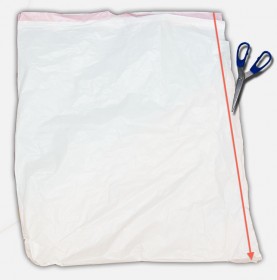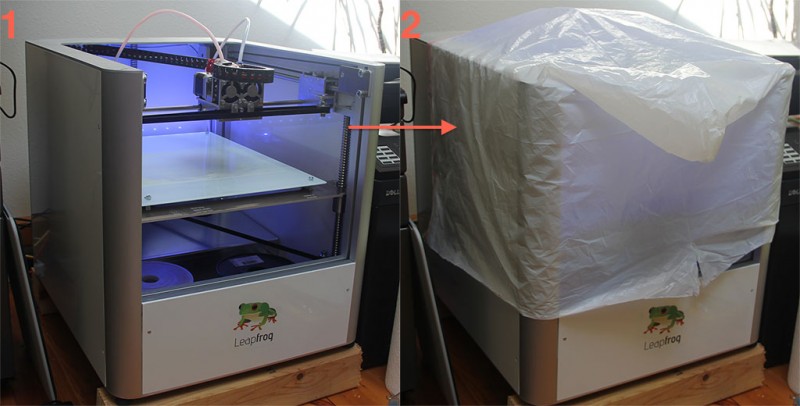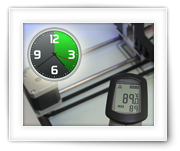Most 3D printer use a heated bed to make sure printed objects stay in place (amongst others).
The principle is based on keeping the object at a certain temperature, so that temperature differences between printed layers will not cause “warping” and even pop your object loose from the bed … and as a result of that screw up your print, and in bad situations even start dragging your object all over the place. (reference)
The time it takes to heat a bed however can take a long time, and frankly, I’m not that patient. So I use a super simple and cheap trick to speed up the heating process of the heated bed. It’s pretty much free and easy to use. I assume this will work for all 3D printers that print with plastics like ABS, but I have only used it with a LeapFrog Creatr so far.
Why does it take forever to get a heated bed to the right temperature?
With most 3D printers, the heated bed is exposed quite a bit. When heating the bed, a lot of the heat is lost to the direct environment.
For example: If you room is 20 degrees Celsius (68 F), and you’re trying to heat your bed to 90 degrees Celsius (194 F), your heated bed will be loosing heat to the room it’s standing in. Not all of it of course, otherwise your room would be getting pretty toasty, but still quite a lot and mostly to the air surrounding your heated bed.
For my LeapFrog Creatr (which even has most sides covered by panels) for example it takes more than an hour to get to 90 C (194 F) in a room that is 20 C (68 F).
Air “conducts” heat poorly, but it “transports” (convection) air pretty good.
That’s why still standing air is applied in insulation techniques like double pane windows.
The same logic is also why moving air is used for your Air-conditioning.
Now you might understand why “moving” should be avoided, as it cools down your bed.
Note : Humidity, or the amount of water molecules in the air, does play a part in this as well – so your milage may vary.
Poor man’s trick to decrease heated bed heating time
First step is of course to make sure that you limit moving air around your 3D printer. So fans, open windows and a lot of motion near the printer should be avoided. We can reduce the airflow with this dirt cheap trick and the results are impressive.
Applying this trick did cut down the heating time for my Leapfrog 3D printer from more than an hour down to 20 minutes – I’d say that’s an improvement for impatient people like myself, and it will save you in the end on your power bill as well.
Heated bed turbo boost
<insert Knight Rider turbo boost sound here>
All we need for this trick is a garbage bag.
I used a straight forward and simple Glad 13 Gallon Trash Bags (50 liter bag) which measures approximately 58 cm (W) x 68 cm (H) or 23 inch (W) x 27 inch (H).
3D printers come in different shapes and sizes so you might need to look for a big bag that first your 3D printer better. This size work beautifully for my LeapFrog Creatr.
Step 1 – Cut one side of the bag
Put the bag on a flat surface, the floor or a table, and cut one side open as shown in the illustration below.

Prepare your garbage bag
Step 2 – Slide the bag over your printer
When you start the process of heating your heated bed, slide the bag over your printer as illustrated below. Notice that the top of the bag is positioned at the top back of my LeapFrog 3D printer. Different 3D printer form or shapes might require a slightly different positioning – as long as all, or at least most, openings of the printer will be covered.
During the heating process, you will notice that the bed heats significantly faster.
When your bed has reached the desired temperature, remove the bag, so it does not block your view when you printer starts printing.

Cover your printer with a garbage bag




Comments
There are 14 comments. You can read them below.
You can post your own comments by using the form below, or reply to existing comments by using the "Reply" button.
Thank you for your Tip, It worked like a charm. My Heat bed is significantly faster in heating.
An phan
Simple and cheap but surprisingly effective …
Thanks for leaving a positive feedback!
hans
Hi,
I was really surprised when I read your article to hear that your heat bed takes an hour to heat up, and that your solution was to put your printer in a rubbish bag. Classic.
Perhaps before designing a solution for everyone you should first see if it’s just your one with this problem.
It’s more likely your heat bed has a problem. My Reprap Prusa i3 takes 1-2 minutes to reach 110 deg. But on one occasion… the first time I used it it took ages. Turns out the temp sensor had come unstuck from under the heat plate ;)
So maybe just look for an obvious solution first.
Regards Lee.
Lee
Hi Lee …
…
You’re right, the heating problem can be related to the heatbed, the power supply, and the printing environment.
I’ve experimented with all of them – except the power supply. It’s a pre-build 3D printer and, even though support at Creatr has been stellar, this problem never got fixed (they even sent me a second printer for free – both printers show the same issue).
Good pointer to check the temp sensor (although the bed didn’t really get all that hot according to my temp-gun) – I’ll give it a try!
Thanks, and … hope I contributed to some personal entertainment ….
….
hans
Wow! That’s incredibly fast, on my Wilson 2 the nozzle heats up in a couple of minutes, but the heatbed takes 13 minutes to reach 95. I have a piece of aluminum foil place shiny side up under the bed to reflect some of the heat that radiates down. Then I have a piece of corrugated cardboard with several wraps of bubble pack around it slid under that. Then, on the topside, I temporarily place a piece of corrugated card over the glass build table while the bed heats and remove it when it reaches temperature,
Mike
I found that my bed problem was burned wires. Check the cable connections for signs of burning g.
wayne
Thanks Wayne for the tip!
I didn’t have that problem with mine, but considering the temperatures, worth a check for sure!
hans
Xendel
Thanks Xendel!
That is indeed a good tip, especially for printers that are home build.
Mine already had this installed,… and I found that using the proper powersupply might have a significant influence as well.
My printer seemed designed for 220V, but the power supply could be switched to 110V.
Running on 110V heating took forever. When I moved to Europe, running the printer on 220V, significantly improved heating speed (still slow though).
I ended up selling mine unfortunately. One of these days I’ll get back into the 3D printing game though … love the concept!
hans
Hello Xendel,
Great to hear this trick.
I also built a reprap prusa i3 with materials I sourced and I normally have very good prints but my bed takes a long time to heat up.
I will try the fiberglass insulation below the bed and will try the rubbish bag over it. But I am afraid that the heated bed is not that great.
Can you note which heated bed you have in your printer?
Great tips
Kind regards
DTM
So glad I found this post. Just got my first 3D printer, an Anet a8. And it was taking over an hour to reach 80c. It seemed to be stuck at 76. After reading your post, I threw a couple garbage bags over it and it jumped 2 degrees in 5minutes. Thanks!
Kevin
Hi Kevin!
That’s great to hear, funny how such a seemingly silly approach is helping right?
I got the idea based on more and more 3D printers being encapsulated, preventing an airflow that might cool down the bed too fast.
Glad it was useful for you as well!
hans
Wow, this is a great idea. I will try this in the future, even though I never really had a problem with my heated beds heating up. I get mine from eBay user 3Dheatbeds. They ship fast & have a quality product that I have not had problems with, but still, great idea.
Hillary
Thanks Hillary!
hans